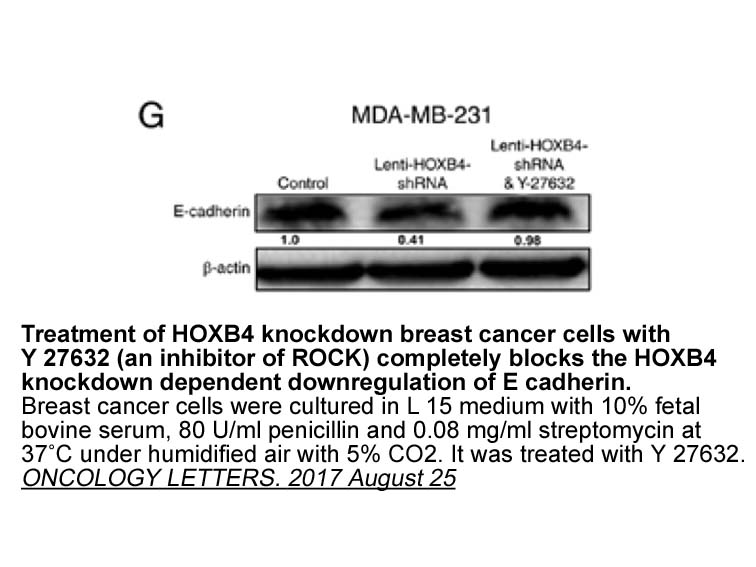Archives
Finally intracrine androgen synthesis metabolism can
Finally, intracrine androgen synthesis/metabolism can be activated thus allowing Mevastatin to bypass the low levels of androgens in the circulation by producing androgens themselves (Cai and Balk, 2011, Rahman et al., 2004). Moreover, changes in AR co-regulators like the overexpression of steroid receptor coactivators can also be correlated with therapy response (Brooke et al., 2008).
Circulation as a source of information
Diagnosis and management of PCa has been undoubtedly improved since the introduction of biomarkers (Crawford et al., 2014). A biomarker can be any molecule that provides additional information on the disease next to the standard clinical parameters. Such molecules can be detected either in the tumor tissues obtained by biopsy or surgery, or in body fluid samples (Prensner et al., 2012). Prostate cancer mainly metastasizes to the bone and lung, and these metastases are not easily biopsied. Fortunately, less invasive means of sampling cancer material through liquid biopsies can still provide a lot of insight into the disease.
Deep sequencing circulating tumor DNA has been applied to mCRPC patients and enabled the detection of mutations and copy number changes that occur before, during or post-treatment (Carreira et al., 2014). Liquid biopsies indeed showed to contain information on the underlying mechanisms of resistance, and thus could lead to better optimization of therapy. The use of CTCs on the other hand needs more sophisticated sampling and larger blood volumes. While they provide information on a much smaller number of cells, they might provide relevant snap-shots of cancer cell features like the changes in transcriptomes.
Conclusions
Conflict of interest
Financial information
Claessens F. holds grants from Fonds Wetenschappelijk Onderzoek-Vlaanderen (GOA9816N, G.0684.12N, G.0830.13N). Van den Broeck T. is supported by a PhD fellowship from Fonds Wetenschappelijk Onderzoek-Vlaanderen (11ZO616N). This work was also supported by the KU Leuven (GOA/15/017) and Kom op tegen Kanker.
Introduction
Prostate cancer is one of the most frequently diagnosed cancers and ranks as the second leading cause of male cancer-related death in the United States (Siegel et al., 2016). One of the hallmarks of prostate cancer is its dependency on androgen and androgen receptor. Several reports have demonstrated that androgen and androgen receptor activation are essential not only for normal prostate growth and maintenance but for the development and progression of prostate cancer (Kim and Coetzee, 2004, Zhao et al., 2014). Androgen ablation therapies, such as medical or surgical castration, effectively treat most cases of primary prostate cancer. Unfortunately, however, most patients ultimately progress to a castration-resistant state (Lonergan and Tindall, 2011).
Androgen, a hormone primarily produced in the testis, is metabolized by 5α-reductase to dihydrotestosterone (DHT), a molecule that binds to androgen receptor (Randall, 1994). DHT binding to androgen receptor induces androgen receptor homodimerization, thereby facilitating the translocation of the androgen receptor complex into the nucleus (Quigley et al., 1995). In the nucleus, the androgen receptor complex binds to specific DNA sequences referred to as androgen response elements, thereby promoting the transcription of androgen-responsive genes such as prostate-specific antigen (PSA), FK506 binding protein 5 (FKBP5), and transmembrane protease serine 2 (TMPRSS2) (Girling et al., 2007, Mostaghel et al., 2007). PSA is strongly associated with total prostate cancer volume and is regarded as the most reliable biomarker for monitoring the presence and progression of prostate cancer (Heinlein and Chang, 2004).
A number of studies evaluating the impact of anesthetics and anesthetic techniques on cancer have recently been reported (Byrne et al., 2016, Sekandarzad et al., 2017). Although surgical resection remains a standard treatment for cancer, surgical manipulation can release tumor cells into the circulation (Pesta et al., 2013). In addition, surgery itself and various secondary factors, including blood loss, acid-base balance disturbance, temperature change, and pain, could induce metabolic, neuroendocrine, and inflammatory responses, and those changes can modify tumor-specific immune responses (Wigmore et al., 2016). As these changes can promote metastasis, perioperative clinical management aimed at preventing cancer progression is considered an important component of cancer treatment. Previous studies evaluating the effects of anesthetics and opioids on cancer progression have reported conflicting results. For example, in vitro studies demonstrated that volatile anesthetics (Santamaria et al., 2010) and opioids (Forget et al., 2010) exert a suppressive effect on the activity of natural killer (NK) cells, cytotoxic lymphocytes that are critical for tumor cell immunity. In contrast, local anesthetics are reported to preserve NK cell activity and the T helper 1/T helper 2 (TH1/TH2) cell ratio in vitro (Wada et al., 2007). Consistent with these studies, local anesthesia combined with general anesthesia showed superior cancer-free su rvival rates compared with general anesthesia alone in prostate (Biki et al., 2008), breast (Exadaktylos et al., 2006), and ovarian cancer patients (de Oliveira et al., 2011). These findings suggest that anesthetics impact disease prognosis in multiple types of cancer. However, large-scale, prospective studies are required to determine which anesthetics and anesthetic techniques are optimal for different types of cancer.
rvival rates compared with general anesthesia alone in prostate (Biki et al., 2008), breast (Exadaktylos et al., 2006), and ovarian cancer patients (de Oliveira et al., 2011). These findings suggest that anesthetics impact disease prognosis in multiple types of cancer. However, large-scale, prospective studies are required to determine which anesthetics and anesthetic techniques are optimal for different types of cancer.